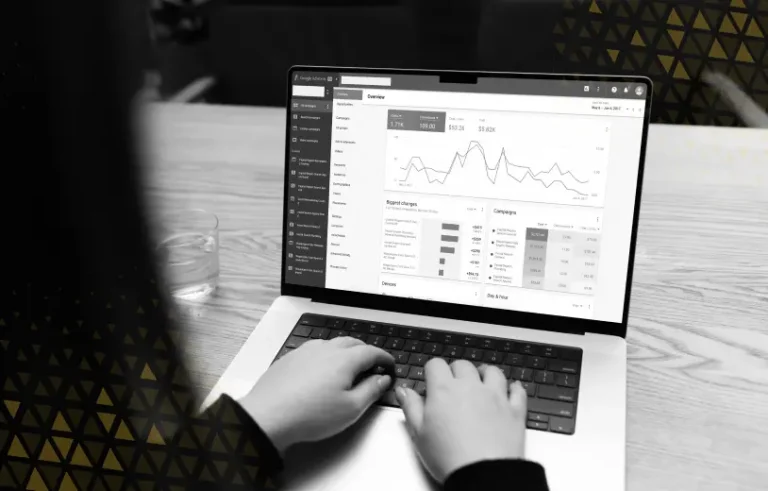As the most popular website-statistics and data-trafficking tool in the world, Google Analytics 4 (GA4) is used by over 28 million websites. If you aren’t leveraging this ROI-boosting tool, chances are: your closest competitors are.
Google Analytics brings functional features and benefits to a wide variety of users. From marketers to business owners, GA4 puts valuable insights into the hands of business stakeholders. It features an intuitive data dashboard, free online training, and countless integrations with other marketing and CRM platforms.
Google Analytics enables users to unify and decipher their data. This gives users insights to understand and improve their PPC strategies. It also shows which parts of their sites are converting visitors into customers. With the addition of artificial intelligence (AI) into the tools used in data analytics, the integration of PPC and GA4 has never been more impactful.
Below, you will learn about:
- High-impact integrations and automations within the Google ecosystem.
- Key reports to analyze and use across ads platforms.
- External integrations to make PPC management more effective.
GA4 offers many more insights into your website. Here, we focus on the advertising impact mostly within the Google space. By looking at your source, audience, and conversion optimization, we keep the conversation focused on PPC.

Which GA4 Reports Provide Insights for Advertising
If you’re new to utilizing Google Analytics for your PPC campaign planning, you need to understand how to pull and utilize reports in GA4. Google Analytics collects data from your channels to create reports with valuable insights.
GA4 Source Reporting Shows Which Sources Bring Traffic
- Source/Medium Report: Analyze traffic origins to identify the most effective channels. This helps optimize ad spend by focusing on sources that balance high traffic with quality conversions.
GA4 Conversion Reports Demonstrate Which Pages and CTAs Have High Impact
- Conversion Paths Report: Visualizes user journeys across channels, highlighting key touchpoints that lead to conversions. This aids in multi-channel attribution and strategy optimization. Regularly validate insights with real user feedback to ensure alignment with actual behavior.
- Events Report: Tracks user interactions such as clicks and form submissions, revealing actions that lead to conversions. This helps optimize engagement strategies. Ensure event tracking accuracy to avoid skewed data.
- ECommerce Purchases Report: Provides insights into purchase behavior and transaction data, aiding in the optimization of eCommerce strategies to boost sales performance. Balance focus on high-value items with the contribution of lower-value items to overall revenue.
- Funnels Analysis Report: Visualizes steps towards conversion goals, identifying drop-off points and improvement areas in the funnel. This helps optimize the conversion process. Consider complex user journeys beyond automated visualizations to avoid oversimplification.
GA4 Audience Reports Help You Know More About Your Customers
- Audience Overview Report: Offers a broad view of audience demographics, including age, gender, and interests, helping tailor PPC campaigns to match target audience characteristics. Avoid broad assumptions based solely on demographic data, and complement with behavioral insights.
- User Explorer Report: Provides detailed data on individual user journeys and interactions, enabling possible personalized marketing strategies and user experience improvements. Use this data to deepen understanding of user behavior.
- Demographics Report: Breaks down audience demographics by age, gender, and location, enhancing targeting precision for PPC campaigns. Ensure demographic data is used alongside behavioral insights for a comprehensive user profile.
The application of this data is to ensure that your ads are reaching the right audience and that once you have them, your site is able to convert. Don’t forget that any of the ads platforms can bring leads if you spend money, but these insights are about optimizing ad collateral/CTAs, your targeting, and your user experience.
Which GA4 Metrics Should You Be Tracking?
Google Analytics 4 usage can be as detailed or as broad as you’d like, depending on: your level of experience; your brand’s relevant key performance indicators; and the overall nature of your PPC campaigns.
Google phased out Universal Analytics in 2023, so getting to know the features of GA4 is vital for PPC managers. In many cases, business owners are only now realizing that data pipelines need to be reestablished. If you are just getting started with using Google Analytics 4 to improve your PPC, we encourage you to focus on traffic sources, audience, and conversions.
PPC is a constantly-shifting field, with costs of entry fluctuating rapidly with demand and viewers responding to social forces as well as predictable trends. This makes intuition and experience less valuable than the ability to read and respond to the data coming from your analytics tools. Fortunately, Google has some valuable automated integrations that create a seamless experience.
Google is an advertising platform first and foremost. Despite all the other benefits and altruistic endeavors it may bring to the world, it is important to remember that all of that is only possible because of the income created by digital advertisers. So, be aware: Google’s motivation remains to make money. Marketers and business owners relying on the set-it-and-forget-it features Google provides risk signing a blank check to Google. You must be judicious in how much license you give Google’s AI to manage your campaigns.

Website Traffic: Volume & Source Info can be used to Bolster Campaign Performance
In GA4, you can identify whether traffic originates from organic searches, paid searches, social media, or other channels. It provides insights into unique visits, session counts, and average engagement time per session for each channel. Understanding how website traffic evolves over time is crucial for discerning which marketing efforts are successful and which need reevaluation. Utilize these insights to make data-driven decisions about the most effective advertising channels for your customers and selected collateral.
Here are several ways website to use the traffic data from GA4 to Google optimize your Google Ads Campaigns:
- Smart Bidding Automation: While GA4 data cannot directly feed into Google Ads Smart Bidding, insights derived from traffic volume and user behavior can inform your Smart Bidding settings. Regularly adjust these settings based on a strategic review of GA4 analytics to ensure bid adjustments are enhancing conversions and ROI without leading to disproportionate cost increases.
- Automated Rules: Implement automated rules in Google Ads to adjust bids, pause keywords, or modify budgets based on performance metrics tracked within Google Ads itself. Use insights from GA4 to inform these decisions and monitor the rules closely to avoid negative impacts, such as prematurely pausing effective keywords.
- Custom Alerts and Reports: Set up custom alerts in GA4 to monitor significant traffic changes. Use this information to manually adjust your Google Ads campaigns, maintaining optimal performance and preventing over-adjustments that could destabilize campaigns.
- Data-Driven Attribution: Apply insights from GA4’s AI-driven attribution to manually adjust the attribution models in Google Ads, aiming for more accurate conversion credit allocation. Frequent changes in attribution models should be approached with caution to avoid inconsistencies in performance metrics.
- Audience Syncing: Sync audience segments from GA4 with Google Ads manually to refine targeting based on the latest traffic analysis. Regularly review the effectiveness of these segments to ensure they align with your campaign goals and avoid targeting misalignments.
- Campaign Optimization Score: Evaluate the relevance of Google’s recommendations by using insights from GA4 regarding traffic patterns to inform the optimization score in Google Ads. These recommendations should be balanced with strategic oversight to ensure they are in line with your broader marketing objectives.
- Mobile Device Insights: Utilize GA4 data on mobile device usage to improve understanding of mobile user experience needs. This information should guide enhancements in mobile-first design and advertising collateral, ensuring optimization for mobile users while maintaining performance across other channels.
Again, Exercise caution with Google’s automated optimization suggestions, which may encourage increased spending or broader reach than necessary, potentially leading to waste and attracting less-qualified traffic. It’s essential to apply human judgment to balance automated tools with business acumen. Be vigilant with settings and opt-outs to avoid steering campaigns towards costly inefficiencies.

Demographic & Audience Data Can be used to Shape Campaigns and Collateral
Understanding your audience is crucial for ensuring your PPC campaigns perform effectively. A comprehensive grasp of who is seeing your ads allows you to tailor your messaging and content more precisely, whether to engage the same demographic more deeply or to pivot towards a different audience segment. GA4 provides an accessible demographics report that categorizes users by age, gender, and interests, offering valuable insights for campaign optimization.
Strategies to Enhance PPC Campaigns Using GA4 Data:
- Google Analytics Intelligence: Utilize GA4’s Analytics Intelligence features to automatically receive insights on demographic trends. While this can speed up the detection of audience shifts, it’s vital to combine these automated insights with human analysis to capture nuanced audience behaviors and preferences.
- Predictive Metrics: Use GA4’s predictive metrics to anticipate demographic trends, facilitating proactive adjustments in your PPC targeting strategies. Always cross-reference these predictions with actual performance data to prevent unnecessary expansions that may increase ad spend without adequate returns.
- Enhanced Audience Segmentation: Leverage GA4’s advanced AI-driven segmentation tools to create finely-tuned demographic segments. This can enhance the precision of your PPC campaigns, but it’s essential to ensure that segmentation doesn’t lead to excessively broad targeting that might dilute campaign effectiveness.
- Google Ads Audience Integration: Manually import GA4 demographic segments into Google Ads to update audience targeting based on the latest insights. While this process isn’t automatic, linking your GA4 and Google Ads accounts allows you to create and refine audience segments based on detailed demographic data in GA4. Once created, these segments can be imported into Google Ads as audiences. Use these audiences to tailor your campaigns more precisely, targeting or excluding specific groups based on their behaviors and characteristics. Regular monitoring and adjustment of these imported segments are essential to ensure that your audience targeting remains effective without leading to excessively broad targeting, which could increase costs and dilute the impact of your campaigns.
- Smart Display Campaigns: When setting up Smart Display campaigns, incorporate learnings from GA4 to select audience characteristics that align with observed user behaviors and preferences. This approach allows you to tailor your ads more effectively, improving the relevance and performance of your campaigns. However, it’s crucial to maintain a balance in audience targeting to avoid excessive broadening, which can lead to inefficient ad spend and diluted campaign effectiveness.
- Dynamic Remarketing: Utilize insights from GA4 demographic analysis to refine your dynamic remarketing strategies in Google Ads to inform the creation of audience segments that are then manually configured within Google Ads. Use these refined segments to target users with ads that dynamically adjust based on their previous interactions with your website or app. Regularly review the performance of these remarketing campaigns to ensure they are reaching the right demographic segments effectively. This approach helps avoid targeting that is too broad or irrelevant, maintaining the efficiency and relevance of your ads.
- Custom Alerts for Demographic Changes: Create custom alerts in GA4 to notify Google Ads of significant demographic shifts, providing valuable notifications when substantial changes occur. You can use these insights as a basis for manually reviewing and adjusting your Google Ads campaigns. Regularly evaluate these alerts to make adjustments, but be sure that they do not lead to frequent and unnecessary changes that could disrupt campaign stability.
This process provides a way to utilize GA4’s rich demographic and behavior data in Google Ads campaigns, but it requires several manual steps to ensure that the right audiences are being targeted effectively. It’s important to periodically revisit the audience data to ensure that your ads remain relevant as user behaviors and preferences evolve.

Conversion & User Journey Data is Insightful for Collateral Creation and Feedback to Advertisers
Understanding the effectiveness of your PPC campaigns through conversion tracking is essential for optimizing user actions like form submissions, product purchases, or service sign-ups. GA4 offers robust tools to set up and analyze conversions, providing a deep dive into user interactions.
- Google Analytics Intelligence: Utilize GA4’s Google Analytics Intelligence to automatically identify trends and anomalies in your conversion data, providing actionable insights to improve your campaigns. However, avoid over-relying on these insights without cross-checking with actual user behavior, as automated suggestions might miss nuanced conversion patterns.
- Enhanced Measurement Events: Leverage GA4’s enhanced measurement events to automatically track key user interactions like clicks, form submissions, and video views. Ensure these automated events are correctly configured in Google Ads to avoid tracking irrelevant actions that could skew conversion data.
- Predictive Metrics: Utilize GA4’s predictive metrics like Purchase Probability and Churn Probability to forecast likely user actions and tailor your PPC strategies for better conversion rates. Always validate these predictions with real-world performance data to avoid overcommitting to trends that might not realize.
- Conversion Path Analysis: Use GA4’s conversion path analysis tools to map out the user journey and identify influential touchpoints that lead to conversions. Be cautious with changes based on these analyses to account for the complexity of user behaviors that automated tools might overlook.
- Data-Driven Attribution: Implement GA4’s data-driven attribution models to distribute conversion credit more accurately across multiple interactions. Regularly review these attribution reports to ensure they truly reflect each channel’s contribution and avoid potential biases introduced by automated models.
- Google Ads Conversion Setup: Use the insights gathered from GA4 to manually inform your Google Ads conversion strategies. This includes setting up conversion actions in Google Ads that reflect the conversion behaviors tracked in GA4.
- Custom Conversion Alerts: Set up custom alerts in GA4 for significant shifts in conversion rates as they can serve as critical indicators for when to manually review and adjust your strategies in Google Ads.
- Conversion Funnels: Use GA4’s conversion funnels to visualize user progression through different stages of the conversion process. Be mindful of potential oversimplifications in automated funnel visualizations, ensuring you consider complex user journeys and interactions.
While GA4’s AI-driven tools significantly enhance the tracking of conversions, it’s crucial to balance these automated capabilities with strategic human analysis. Treat optimization as a controlled experiment, making incremental changes to accurately gauge their impact. Consider running parallel campaigns to test different adjustments and determine the most effective strategies.
PPC is a combination of expertly-crafted content and delivering it to the right people at the right times. Without PPC management, even the best content can miss your audience. Google Analytics enables users to unify and decipher their data and, in turn, better understand how to improve their PPC strategies.
Which Integrations are Best for GA4 and Managing PPC
GA4 utilizes tagged events and conversions that can be tracked and information shared with many platforms. In order to optimize your data tracking for PPC planning, there are a few Google Analytics integrations that are valuable to understand.
- Google Ads Integration: Link GA4 with Google Ads to enhance data sharing between the two platforms, facilitating access to detailed multi-channel reports and unified performance insights. This integration allows you to better understand the paths leading to conversions and refine your campaign strategies effectively. While it provides valuable data on conversion sources and campaign effectiveness, ensure that your strategy doesn’t become overly focused on easily achievable conversions. Aim to balance your efforts by also targeting higher-value goals that may require more complex strategies and longer-term lead nurturing.
- Google Search Console Integration: Connect GA4 with Google Search Console to gain insights into your website’s SEO performance. This integration provides visibility into popular search queries, keyword effectiveness, and comparative insights, which are valuable for adjusting SEO strategies. Regularly review this integration to ensure it supports a balanced approach to driving both traffic and conversions, without overemphasizing less effective keywords.
- CRM Platform Integration: Integrate GA4 with your CRM platform to unify data across all customer interactions, providing a comprehensive view of the customer journey. This integration is crucial for tailoring marketing strategies based on customer behavior and engagement patterns. However, prioritize key metrics to avoid overwhelming decision-making processes with too much data.
- ECommerce Platform Integration: Connect GA4 with your eCommerce platform to track detailed transaction data, customer behavior, and product performance throughout the customer journey. Ensure this integration is comprehensive, capturing all stages from initial engagement to post-purchase behavior, to avoid any gaps that could skew data analysis.
- Social Media Data Analysis with GA4: While GA4 cannot be directly linked to social media platforms to automatically track engagement metrics and conversions, you can use UTM parameters to track social media referral traffic in GA4. By tagging your social media campaign URLs with UTM parameters, you can effectively monitor how much traffic, engagement, and conversions are driven by each social media channel and ad set. This data is crucial for assessing how social media contributes to your overall marketing goals. Ensure that your analysis of social media metrics aligns with broader strategies that prioritize conversions and ROI, integrating these insights into your comprehensive marketing analysis.
Properly utilizing these integrations provides a robust feedback mechanism for understanding your audience, products, sales cycle, and the overall value of purchases. By leveraging data from these integrations, you can gain deep insights into Return on Ad Spend (ROAS), the cost of customer acquisition, and the effectiveness of different channels in generating quality leads. These insights enable you to make informed decisions about allocating resources and optimizing strategies across various platforms to enhance your advertising efforts.
How can a Marketing Agency Help Equip your Analytics and PPC Accounts for Success
It is important to remember a few things about Google ads and analytics: Google’s number one priority is Google; Making lots of changes at one time can diminish your returns and obscure what was actually impactful; and You need to know your KPIs and goals ahead of time. By understanding what each feature is capable of, you can set realistic goals. Do take the time to consult with an agency or research the options thoroughly to gain insights that lead to high-impact results.
While Google Analytics and PPC are obviously complementary practices, it can be difficult to ride the learning curve for campaign creation and analysis simultaneously. If you are a new player in the PPC game or you lack extensive Google Analytics experience, consider hiring an agency that understands PPC strategy and tools. Often, business owners can maintain campaigns themselves once they are established. Following a pattern is more achievable than setting up the initial conversions and data connections.
Are you ready to revamp your PPC strategy? Fahrenheit Marketing can deliver custom solutions to relieve the stress of managing your PPC accounts. We utilize Google Analytics 4 and Search Console to diagnose and remedy any underlying issues with your strategy and deliver measurable results for your business. Fahrenheit Marketing is a digital marketing agency in Austin, TX that prides itself on a client-first mentality. Want to see some of our exceptional work? Check out our portfolio.